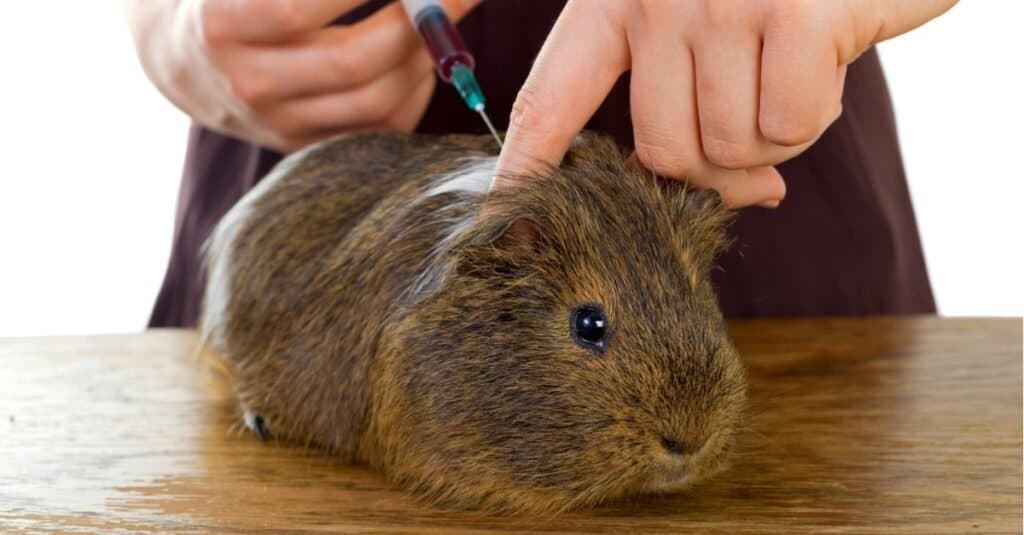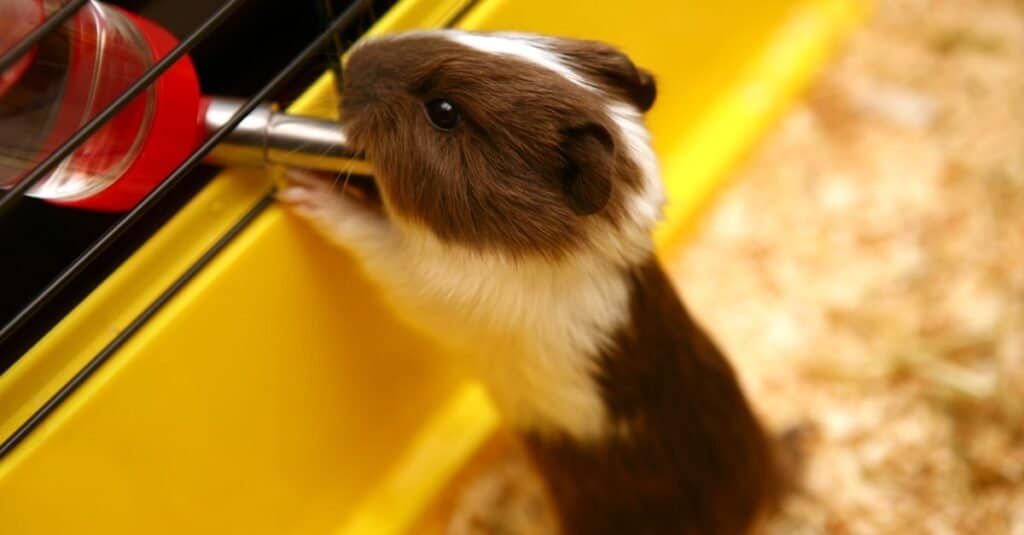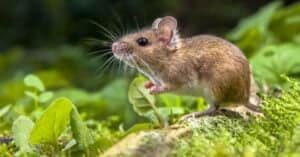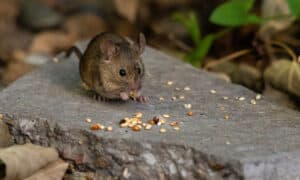A bladder stone, also known as uroliths, is a very serious and painful condition that occurs in many animals, including guinea pigs. The “stone” itself is really just a buildup of tiny crystals that becomes lodged in the bladder (which stores the urine) or even the urethra (where the urine is dispensed from the body). Since this condition can result in pain, bleeding, psychological distress, and even death, your pig should receive a full evaluation from the vet as soon as possible once you suspect it might have bladder stones.
Unfortunately, once the stone has developed, the actual treatment options are limited, and guinea pigs appear to be particularly susceptible to them. This article will cover almost everything you need to know about the causes, symptoms, diagnosis, and treatment of bladder stones in guinea pigs.
What Causes a Bladder Stone?
There are several factors that influence the creation of a bladder stone. A sudden change in the urine’s acidity level (measured as pH) appears to play a significant role. Too much calcium oxalate in the diet (a common component of spinach, parsley, and strawberries) may contribute to the buildup of crystals. Genetic factors also appear to significantly increase the risk of a bladder stone, meaning some pigs are just more predisposed to it than others. Another mechanism that may increase the odds is poor urinary health, including the presence of a urinary tract infection.
How these factors interact with and influence each other is still a bit of a mystery. It’s possible that every individual pig is just a little bit different. But regardless of the risk factors, the bladder stone usually develops in the same way each time. As the risk factors compound, small minerals, and proteins form tiny crystals in the bladder, which then develop into one or more stones. There are several types of stones, each with a different chemical composition, but those particular details are unimportant for the purpose of this article.

©iStock.com/Ocskaymark
What Are the Symptoms of a Bladder Stone?
The symptoms of a bladder stone may start subtly, even ambiguously, and then gradually develop into something more serious. Your guinea pig may begin to experience pain in the abdomen (which is sensitive to the touch) or changes in the frequency of urination (to the point where it might not urinate at all). This can result in the pig neglecting other aspects of its life if it’s trying to urinate often. Blood in the urine is also a very common symptom as well. The pig may squat down or even squeal in pain when it’s attempting to urinate. A urinary tract infection is often associated with a bladder stone and is sometimes diagnosed at the same time.
If the stone is still small and gradually forming, you may not notice very many symptoms at all. But once it begins to really develop, the condition can get quite serious. The worst possible outcome is when the stone becomes lodged in the urethra. This can lead to acute kidney failure, sepsis, and hyperkalemia (elevated blood potassium levels). Death will then follow within just a few days.
Fortunately, simply knowing the signs of a bladder stone and checking your pig frequently for the symptoms will go a long way toward avoiding the worst outcomes. Keep a close eye on your guinea pig to recognize the signs before it’s too late.
How Is a Bladder Stone Diagnosed?
If your guinea pig begins to experience any of these symptoms, then the first step is to contact your vet immediately. They will usually perform a full physical examination with a urinalysis and an X-ray. A urinalysis can identify the presence of crystals (along with blood or signs of a bacterial infection) in the urine, while an X-ray (or alternatively an ultrasound) is usually the best way to analyze the composition and location of the stone. Some stones may be too small to identify at first, but the vet should have alternatives ready in those particular cases.
How Is a Bladder Stone Treated?
A bladder stone is among the trickier medical conditions to properly treat in a guinea pig. Unlike other animals, the stone can’t be dissolved by medication, and if left untreated, it usually starts to become progressively worse over time. If the stone is still quite small, then it might be flushed out naturally with increased water intake, though at some pain to the pig. A low-calcium diet, medication, or other tips prescribed by your vet may prevent it from growing even further. If there’s a urinary tract infection present encouraging the growth of the stones, then your vet may also prescribe antibiotics to deal with it. That is why it’s important to identify the bladder stone as soon as possible. It’s easiest to handle if it’s diagnosed early in its progression.
If the stone is too large to flush out through urine, however, then surgery might be the only option. The surgeon will attempt to create an incision and remove the stone by hand. However, this procedure can become much more complicated once the stone has passed out of the bladder and into the trigone (the path leading to the urethra) or the urethra itself. In the worst-case scenario, the stone can tear a hole in the urethra wall, causing urine to back up into the abdomen instead of exiting the body. If the damage is severe enough, then euthanasia is sometimes the only option remaining.
It should be mentioned that euthanasia is only necessary in a small minority of cases. As long as you are taking all the necessary precautions to avoid a bladder stone, the condition rarely becomes that severe. Unfortunately, some guinea pigs have a natural predisposition to the frequent development of bladder stones, and despite all your best efforts, the problem may keep reoccurring. In those cases, the vet will help you make the best decision as to whether further treatment is warranted. If the drop in its quality of life is just too severe, then euthanasia may again be the best course of action.
Steps to Avoid Bladder Stones

©Gordana Sermek/Shutterstock.com
It should be stressed that the bladder stone is a tricky condition. Because we still don’t know exactly how risk factors interact and contribute to their formation, there is no surefire treatment or prescription for avoiding them. Bladders stones are influenced by several factors you simply have no control over. Fortunately, there are a few things you can control.
One of the most important is your guinea pig’s diet. Try to limit its intake of calcium and/or oxalate from food items such as spinach or strawberries. You don’t have to completely eliminate these foods from its diet, but limit them to one or two servings per week. A well-balanced diet with plenty of different foods in which nothing particularly dominates should be sufficient. Lettuce is usually a very good all-around healthy choice for a basic dietary staple and doesn’t contain very much calcium. Make sure the pellets you buy do not contain any extra calcium either; dietary supplements are also completely unnecessary unless recommended by your vet. The nutrients obtained from a normal diet should be good enough in almost all cases to satisfy your pig without resulting in any excessive intake.
Another important thing to keep in mind is urinary health. A lot of owners neglect this aspect of their pig’s care until it is already too late. This is too bad because it can lead to numerous health complications later on down the road. In order to improve its urinary health, owners should provide plenty of clean drinking water at all times of the day to encourage regular healthy urination. Cages with more than one pig may require multiple water bottles as well, since one pig may tend to dominate a single water bottle.
Another thing you will want to do is provide clean and dry bedding, replaced fairly often, perhaps about once a week. If you leave around wet and dirty bedding, then it may just encourage bacterial growth in the cage. This in turn increases the odds of a urinary tract infection, which is closely associated with the development of bladder stones. Trimming the hairs around the rump can help as well to limit bacterial growth.
Since genetics is thought to play an important role in the formation of bladder stones, you may be able to decrease the odds by choosing a guinea pig without a family history of the condition. Trusted, high-quality breeders will always keep a careful health profile of their guinea pig breeding stock by performing frequent tests and evaluations. Never trust a breeder or store that cannot verify the source of their pigs.
Random or uncontrollable factors will always play a significant role in the health of any animal. But if you take these precautions seriously, and you’re always on the lookout for signs of a progressing illness, then you can dramatically reduce the odds of a serious health complication or crisis resulting from bladder stones.
Up Next…
Keep your little, furry friend in tip top shape. Here are some links all about guinea pigs!
- Guinea Pig Types: The Ultimate Guide To Guinea Pig Breeds If you’re about to adopt a guinea pig, check out the different breeds!
- Guinea Pig Diet: What Do Guinea Pigs Eat? Get your guinea pig meal plan here.
- Guinea Pig Nail Clipping: How To Trim Guinea Pig Nails Trimming your pet’s nails can cause a lot of anxiety. Here are tips for clipping your guinea pig’s tips!
The photo featured at the top of this post is © Tatyana Vyc/Shutterstock.com
Thank you for reading! Have some feedback for us? Contact the AZ Animals editorial team.







